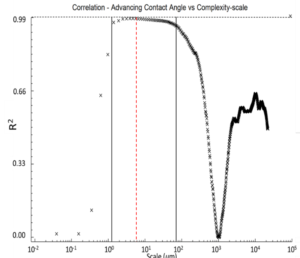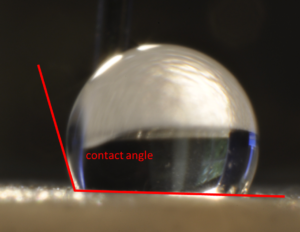WETTING PROJECT
Participating Professors: Professor Daniello
Student Research Assistants: Aidan Sevinsky, Macey McEnaney, Rachel Chan
An investigation of the Role of Area, Scale, and Hierarchical Surface Topography in Wetting and Drying of Stochastically-Patterned Surfaces
The topography of a surface affects the manner in which that surface interacts with its surroundings. In this way small scale localized features of a surface can change the apparent bulk properties of a material. The way in which water interacts with a maerial is one such behavior strongly influenced by the microfeatures present on the surface (in combination with the chemistry of the material itself). We term this behavior “wettability”. The present project involves the study of how surface topography affects wettability and evaporation rate utilizing multiscale analysis for correlation and discrimination, a technique developed in the WPI Surface Metrology Lab which identifies both topographical parameters and scales that affect the measured macroscale performance of the bulk object. In this case, droplet contact angle for wetting and evaporation rate for drying.
Wetting is quantified with contact angle, the angle made between the macroscale surface and the tangent of the drop at the point where the drop touches the surface. The more water repellent the surface, the higher the contact angle and the closer to spherical a small drop will appear.

Contact angle is measured photographically on drops in both the advancing and receding conditions providing a quantitative measure of a surface’s resistance to droplet spread (advancing contact angle), de-wetting (receding contact angle), and the mobility of droplets (hysteresis). Evaporation rate is measured using droplet observations and directly from permeable surfaces with constant water level bottle and controlled environment chamber constructed for these experiments. Surface topography is measure with laser scanning confocal miscroscopy (Sensofar) and correlations with wetting/drying measurements are performed utilizing software tools developed in the lab.
Initial results from wetting measurements show excellent correlation with surface complexity (a.), the rate at which the apparent area of the surface increases as the scale of observation becomes finer, over the range of scales ~1-70 μm (b.) . Additional wetting correlations and drying measurements underway.

